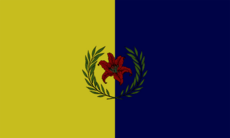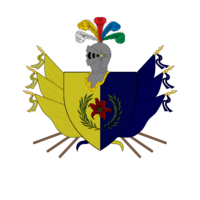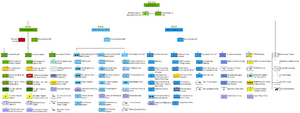Valorea: Difference between revisions
mNo edit summary |
No edit summary |
||
| (11 intermediate revisions by 2 users not shown) | |||
| Line 5: | Line 5: | ||
|common_name = Valorea <br> ''Valorea'' | |common_name = Valorea <br> ''Valorea'' | ||
|image_flag = [[File:Valorean_Flag_3.5_1_resize.png|230px]] | |image_flag = [[File:Valorean_Flag_3.5_1_resize.png|230px]] | ||
|image_coat = | |image_coat = [[File:ValoreaCoatOfArmsWIP.png|200px]] | ||
|symbol_type = | |symbol_type = | ||
|national_motto = Per Valore e Gloria! <br><small>''For Valor and Glory!''</small> | |national_motto = Per Valore e Gloria! <br><small>''For Valor and Glory!''</small> | ||
| Line 22: | Line 22: | ||
|capital = [[Porto Cervo]] | |capital = [[Porto Cervo]] | ||
|largest_city = [[Porto Cervo]] | |largest_city = [[Porto Cervo]] | ||
|official_languages | |official_languages = {{wp|Italian language|Vespasian}} | ||
|national_languages = | |||
|regional_languages = Native Languages | |regional_languages = Native Languages | ||
|languages_type = | |languages_type = | ||
|languages = | |languages = | ||
|ethnic_groups = | |ethnic_groups = 77.2% Mulatto (mix between Euclean colonizers, mainly Etrurian, and natives), 9.4% Natives (Mapuche and Makotana peoples), 6.8% Euclean, 6.6% Other | ||
|ethnic_groups_year = | |ethnic_groups_year = 2019 | ||
|demonym = Valorean | |demonym = Valorean | ||
|upper_house = The Senate | |upper_house = The Senate | ||
| Line 88: | Line 88: | ||
|HDI_category = | |HDI_category = | ||
|currency = Valorean Florin | |currency = Valorean Florin | ||
|currency_code = | |currency_code = VAF | ||
|time_zone = +15 | |time_zone = +15 | ||
|utc_offset = | |utc_offset = | ||
|time_zone_DST = | |time_zone_DST = No DST | ||
|antipodes = | |antipodes = | ||
|date_format = dd.mm.yyyy | |date_format = dd.mm.yyyy | ||
| Line 98: | Line 98: | ||
|drives_on = right | |drives_on = right | ||
|cctld = .val | |cctld = .val | ||
|iso3166code = | |iso3166code = VA | ||
|calling_code = | |calling_code = | ||
|image_map3 = | |image_map3 = | ||
| Line 142: | Line 142: | ||
===Territorial Subdivisions=== | ===Territorial Subdivisions=== | ||
====Regions==== | |||
Since indipendence Valorea has been subdivided into seven Regions: | |||
{| class="wikitable" | |||
!Name!!Region Capital!!Population!!Governor! | |||
|- | |||
| [[Arusiana (Valorea)|Arusiana]]||[[Porto Cervo]]|| 3,376,562||[[Vego Armini]] | |||
|- | |||
| [[Nuovo Mondo (Valorea)|Nuovo Mondo]] || [[Mailana]] || 2,737,115|| [[Riace Mistrino]] | |||
|- | |||
| [[Oceania (Valorea)|Oceania]] || [[Spezia]] || 1,987,430 || [[Eleonora Felara]] | |||
|- | |||
| [[Lavalle (Valorea|Lavalle]] || [[Efero]] || 978,451|| [[Giorgio Foret]] | |||
|- | |||
| [[Maremma (Valorea)|Maremma]] || [[Massa]] || 693,076 || [[Simone Calacoro]] | |||
|- | |||
| [[Mastròvia (Valorea)|Mastròvia]] || [[San Siro]] || 612,396 || [[Javen Khulio]] | |||
|- | |||
| [[Capo (Valorea)|Capo]] || [[Cadore]] || 484,319 || [[Rovanno Borcarin]] | |||
|} | |||
The region is represented by the president of the region which is directly and democratically elected through regional elections by universal suffrage among all citizens of the region. | |||
Administrative functions are attributed to the regional junta, made up of assessors appointed by the president of the region to represent the political forces that supported him. | |||
The region has a regional parliament, an equivalent collegial body of Parliament at the state level, composed of regional councilors (the number of which is proportional to the region's population) representing all the political forces of the territory with the functions of approving the regional budget, resolutions and provisions issued by the president / junta. The parliament exercises legislative power for the matters that the Constitution delegates to the exclusive or concurrent legislative power of the region. | |||
====Counties==== | |||
Regions are further subdivided into a number of counties. | |||
The administrative organization of a county is the following: | |||
At the head of the county there is the county mayor, democratically elected through county elections by universal suffrage among all municipal citizens, with executive powers together with the county council, a collegial body composed of a variable number of county councilors appointed by him to represent the political forces that support him (equivalent of the council of ministers and the head of government at the state level). The county mayor resides in the county hall during his work with a term of office that lasts 4 years unless he resigns or dies. | |||
Supervising everything is the county council, an equivalent collegiate body of Parliament at the state level, made up of county councilors representing all the political forces of the territory with the functions of approving the municipal budget, the resolutions and provisions issued by the county mayor / council ( e.g. ordinances). In addition to the figure of councilor and councilor, another key figure at the administrative level is that of the county secretary. The administrative activity typically takes place in the county hall which also acts as a place with direct relations with citizens. | |||
The county is responsible for the administration of the territory as regards: | |||
definition and compliance with the annual municipal budget; | |||
definition and compliance with the municipal general plan; | |||
management of municipal roads; | |||
management of public buildings; | |||
waste disposal; | |||
management of critical issues related to bad weather and natural disasters; | |||
county level public transportation. | |||
If a county has more than one inhabitated settlement, it is further subdivided into cities and fractions, depending on population. The county council may approve ordinances that only apply to a certain city or fraction. While a fraction does not have any political organs, a city has it's own city major and city council, both of which are voted every 4 years (at the same time as the county elections). The administration responsibility of a city is variable between counties. | |||
===Law=== | ===Law=== | ||
| Line 152: | Line 201: | ||
[[File:Valorean Armed Forces Orbat.png|thumb|right|OrBat of the Valorean Armed Forces (only combat units of the Carabineers Arm shown).]] | [[File:Valorean Armed Forces Orbat.png|thumb|right|OrBat of the Valorean Armed Forces (only combat units of the Carabineers Arm shown).]] | ||
The Valorean Armed Forces are the armed forces of Valorea, with the President of the Republic as its commander-in-chief. They are divided into four Arms: the [[Valorean Republicam Army|Valorean Republican Army]] ({{wp|Italian language|Vespasian}}: ''Esercito Repubblicano Valoreano''), the [[Valorean Republican Navy|Valorean Republican Navy]] ({{wp|Italian language|Vespasian}}: ''Marina Militare Repubblicana Valoreana''), the [[Valorean Republican Airforce|Valorean Republican Airforce]] ({{wp|Italian language|Vespasian}}: ''Aeronautica Repubblicana Valoreana'') and the [[Arm of Carabineers|Arm of Carabineers]] ({{wp|Italian language|Vespasian}}: ''Arma dei Carabinieri''). Complementing the four arms, there are also two Independent commands under the Joint Armed Forces Command: the Medical Support Brigade, which with | The Valorean Armed Forces are the armed forces of Valorea, with the President of the Republic as its commander-in-chief. They are divided into four Arms: the [[Valorean Republicam Army|Valorean Republican Army]] ({{wp|Italian language|Vespasian}}: ''Esercito Repubblicano Valoreano''), the [[Valorean Republican Navy|Valorean Republican Navy]] ({{wp|Italian language|Vespasian}}: ''Marina Militare Repubblicana Valoreana''), the [[Valorean Republican Airforce|Valorean Republican Airforce]] ({{wp|Italian language|Vespasian}}: ''Aeronautica Repubblicana Valoreana'') and the [[Arm of Carabineers|Arm of Carabineers]] ({{wp|Italian language|Vespasian}}: ''Arma dei Carabinieri''). Complementing the four arms, there are also two Independent commands under the Joint Armed Forces Command: the Medical Support Brigade, which with its {{wp|Field hospital|field hospitals}} can intervene in military conflicts as well as help the civilian population in case of natural calamities or other emergencies, and the {{wp|ISTAR|ISTAR}}-{{wp|Electronic_warfare|EW}} Brigade, which provides the Valorean Armed Forces varied intelligence assets as well as electronic warfare equipment and personell. | ||
The Armed Forces are controlled by the Ministry of Defence, with the Carabineers falling under joint control of the Ministry of Defence and the Ministry of Internal Affairs, since it acts as the State Police Force as well. The commander-in-chief of the Armed Forces is the President of the Republic (currently: Cesare Mezzarin), which has at | The Armed Forces are controlled by the Ministry of Defence, with the Carabineers falling under joint control of the Ministry of Defence and the Ministry of Internal Affairs, since it acts as the State Police Force as well. The commander-in-chief of the Armed Forces is the President of the Republic (currently: Cesare Mezzarin), which has at its disposition the Joint Armed Forces Command. The Command is formed by the President, the Minister of Defence, the Chief of Staff of each Arm of the Armed Forces, the Director (or a delegate of his) of the [[Valorean Intelligence Service]] and a Joint Chief of Staff. | ||
Valorea has an estimated defence budget of $3.742.501.639, which is 2.9% of the National GDP. The Armed Forces are heavily reliant on imported military equipment, since defence industries are negligible and only produce limited quantities of equipment. Most of the equipment is imported from [[Treaty of Avelon|NVO]] and [[ECDTO]]. | Valorea has an estimated defence budget of $3.742.501.639, which is 2.9% of the National GDP. The Armed Forces are heavily reliant on imported military equipment, since defence industries are negligible and only produce limited quantities of equipment. Most of the equipment is imported from [[Treaty of Avelon|NVO]] and [[ECDTO]]. | ||
Latest revision as of 16:25, 14 August 2020
This article is incomplete because it is pending further input from participants, or it is a work-in-progress by one author. Please comment on this article's talk page to share your input, comments and questions. Note: To contribute to this article, you may need to seek help from the author(s) of this page. |
Valorean Republic Valorean Republic Repubblica Valoreana | |
|---|---|
| Motto: Per Valore e Gloria! For Valor and Glory! | |
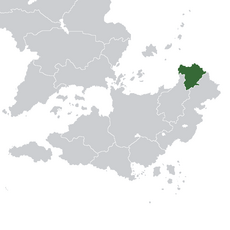 Position of Valorea in Asteria Inferior | |
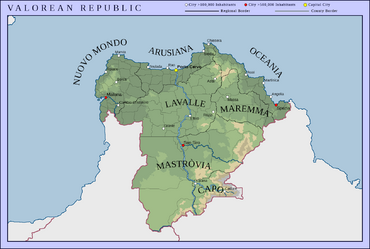 Phyisical Map of Valorea with major cities and internal subdivisions shown | |
| Capital and largest city | Porto Cervo |
| Official languages | Vespasian |
| Recognised regional languages | Native Languages |
| Ethnic groups (2019) | 77.2% Mulatto (mix between Euclean colonizers, mainly Etrurian, and natives), 9.4% Natives (Mapuche and Makotana peoples), 6.8% Euclean, 6.6% Other |
| Demonym(s) | Valorean |
| Government | Unitary Parliamentary Republic |
• President of the Republic | Cesare Mezzarin |
• Prime Minister | Viviana Rastaga |
| The Senate | |
| The Chamber | |
| Establishment | |
• Discovery by Povelian Merchants | 1522 |
| Area | |
• | 476,108.03 km2 (183,826.34 sq mi) |
| Population | |
• 2019 census | |
• Density | 23.22/km2 (60.1/sq mi) |
| GDP (PPP) | 2019 estimate |
• Total | |
• Per capita | |
| GDP (nominal) | 2019 estimate |
• Total | |
• Per capita | |
| Gini (2017) | medium |
| HDI (2019) | very high |
| Currency | Valorean Florin (VAF) |
| Time zone | +15 |
• Summer (DST) | No DST |
| Date format | dd.mm.yyyy |
| Driving side | right |
| ISO 3166 code | VA |
| Internet TLD | .val |
Valorea, officially Valorean Republic (Vespasian: Repubblica Valoreana) is a sovereign country in Asteria Inferior. It's only neighbouring nation is Caluchia to the south-west, while bordering the West Arucian Sea to the north-west and the Lumine Ocean to the north and east. The Republic is organized in 7 regions, which are further divided in Counties. Valorea is a Unitary Parliamentary Republic with Porto Cervo as it's capital, which is also the largest city, both by economy and population. Other major cities include Mailana (the first city founded in the country), Spezia (a major tourist destination) and San Siro (a major industrial center).
History
Pre-colonial era
Povelian colonization
Independence
Industrial Era
The Great War
Post-War
70's Police State
80's - Today
Geography
Climate
Physical Composition
Biodiversity
Politics
Government
Territorial Subdivisions
Regions
Since indipendence Valorea has been subdivided into seven Regions:
| Name | Region Capital | Population | Governor! |
|---|---|---|---|
| Arusiana | Porto Cervo | 3,376,562 | Vego Armini |
| Nuovo Mondo | Mailana | 2,737,115 | Riace Mistrino |
| Oceania | Spezia | 1,987,430 | Eleonora Felara |
| Lavalle | Efero | 978,451 | Giorgio Foret |
| Maremma | Massa | 693,076 | Simone Calacoro |
| Mastròvia | San Siro | 612,396 | Javen Khulio |
| Capo | Cadore | 484,319 | Rovanno Borcarin |
The region is represented by the president of the region which is directly and democratically elected through regional elections by universal suffrage among all citizens of the region.
Administrative functions are attributed to the regional junta, made up of assessors appointed by the president of the region to represent the political forces that supported him.
The region has a regional parliament, an equivalent collegial body of Parliament at the state level, composed of regional councilors (the number of which is proportional to the region's population) representing all the political forces of the territory with the functions of approving the regional budget, resolutions and provisions issued by the president / junta. The parliament exercises legislative power for the matters that the Constitution delegates to the exclusive or concurrent legislative power of the region.
Counties
Regions are further subdivided into a number of counties.
The administrative organization of a county is the following:
At the head of the county there is the county mayor, democratically elected through county elections by universal suffrage among all municipal citizens, with executive powers together with the county council, a collegial body composed of a variable number of county councilors appointed by him to represent the political forces that support him (equivalent of the council of ministers and the head of government at the state level). The county mayor resides in the county hall during his work with a term of office that lasts 4 years unless he resigns or dies.
Supervising everything is the county council, an equivalent collegiate body of Parliament at the state level, made up of county councilors representing all the political forces of the territory with the functions of approving the municipal budget, the resolutions and provisions issued by the county mayor / council ( e.g. ordinances). In addition to the figure of councilor and councilor, another key figure at the administrative level is that of the county secretary. The administrative activity typically takes place in the county hall which also acts as a place with direct relations with citizens.
The county is responsible for the administration of the territory as regards:
definition and compliance with the annual municipal budget; definition and compliance with the municipal general plan; management of municipal roads; management of public buildings; waste disposal; management of critical issues related to bad weather and natural disasters; county level public transportation.
If a county has more than one inhabitated settlement, it is further subdivided into cities and fractions, depending on population. The county council may approve ordinances that only apply to a certain city or fraction. While a fraction does not have any political organs, a city has it's own city major and city council, both of which are voted every 4 years (at the same time as the county elections). The administration responsibility of a city is variable between counties.
Law
Foreign Relations
Military
The Valorean Armed Forces are the armed forces of Valorea, with the President of the Republic as its commander-in-chief. They are divided into four Arms: the Valorean Republican Army (Vespasian: Esercito Repubblicano Valoreano), the Valorean Republican Navy (Vespasian: Marina Militare Repubblicana Valoreana), the Valorean Republican Airforce (Vespasian: Aeronautica Repubblicana Valoreana) and the Arm of Carabineers (Vespasian: Arma dei Carabinieri). Complementing the four arms, there are also two Independent commands under the Joint Armed Forces Command: the Medical Support Brigade, which with its field hospitals can intervene in military conflicts as well as help the civilian population in case of natural calamities or other emergencies, and the ISTAR-EW Brigade, which provides the Valorean Armed Forces varied intelligence assets as well as electronic warfare equipment and personell.
The Armed Forces are controlled by the Ministry of Defence, with the Carabineers falling under joint control of the Ministry of Defence and the Ministry of Internal Affairs, since it acts as the State Police Force as well. The commander-in-chief of the Armed Forces is the President of the Republic (currently: Cesare Mezzarin), which has at its disposition the Joint Armed Forces Command. The Command is formed by the President, the Minister of Defence, the Chief of Staff of each Arm of the Armed Forces, the Director (or a delegate of his) of the Valorean Intelligence Service and a Joint Chief of Staff.
Valorea has an estimated defence budget of $3.742.501.639, which is 2.9% of the National GDP. The Armed Forces are heavily reliant on imported military equipment, since defence industries are negligible and only produce limited quantities of equipment. Most of the equipment is imported from NVO and ECDTO.
Valorea is an NVO associate, meaning that the Valorean Armed Forces get easier equipment import agreements with the member nations, can participate in international training programs (some of which run in Valorean Territory) and take part in NVO joint Missions, while not being part of the Mutual Defence Agreement. That has given acces to the Valorean Armed Forces to a higher standard of training compared to the Asteria Inferior counterparts, and to fairly modern equipment despite the small budget.
